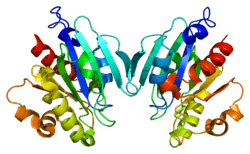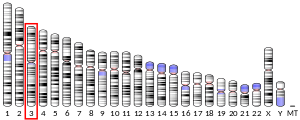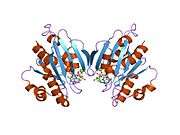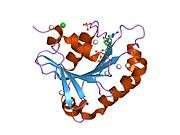ARF4
ADP-ribosylation factor 4 is a protein that in humans is encoded by the ARF4 gene.[4][5]
Function
ADP-ribosylation factor 4 (ARF4) is a member of the human ARF gene family. These genes encode small guanine nucleotide-binding proteins that stimulate the ADP-ribosyltransferase activity of cholera toxin and play a role in vesicular trafficking and as activators of phospholipase D. The gene products include 5 ARF proteins and 11 ARF-like proteins and constitute 1 family of the RAS superfamily. The ARF proteins are categorized as class I (ARF1 and ARF3), class II (ARF4 and ARF5) and class III (ARF6). The members of each class share a common gene organization. The ARF4 gene spans approximately 12kb and contains six exons and five introns. The ARF4 is the most divergent member of the human ARFs. Conflicting Map positions at 3p14 or 3p21 have been reported for this gene.[5]
Interactions
ARF4 has been shown to interact with Epidermal growth factor receptor[6] and with RVxP motifs.[7]
References
- GRCh38: Ensembl release 89: ENSG00000168374 - Ensembl, May 2017
- "Human PubMed Reference:". National Center for Biotechnology Information, U.S. National Library of Medicine.
- "Mouse PubMed Reference:". National Center for Biotechnology Information, U.S. National Library of Medicine.
- Monaco L, Murtagh JJ, Newman KB, Tsai SC, Moss J, Vaughan M (Apr 1990). "Selective amplification of an mRNA and related pseudogene for a human ADP-ribosylation factor, a guanine nucleotide-dependent protein activator of cholera toxin". Proc. Natl. Acad. Sci. U.S.A. 87 (6): 2206–10. doi:10.1073/pnas.87.6.2206. PMC 53655. PMID 2107548.
- "Entrez Gene: ARF4 ADP-ribosylation factor 4".
- Kim SW, Hayashi M, Lo JF, Yang Y, Yoo JS, Lee JD (Jan 2003). "ADP-ribosylation factor 4 small GTPase mediates epidermal growth factor receptor-dependent phospholipase D2 activation". J. Biol. Chem. 278 (4): 2661–8. doi:10.1074/jbc.M205819200. PMID 12446727.
- Ward, Heather H.; Brown-Glaberman, Ursa; Wang, Jing; Morita, Yoshiko; Alper, Seth L.; Bedrick, Edward J.; Gattone, Vincent H.; Deretic, Dusanka; Wandinger-Ness, Angela (20 July 2011). "A conserved signal and GTPase complex are required for the ciliary transport of polycystin-1". Molecular Biology of the Cell. 22 (18): 3289–3305. doi:10.1091/mbc.e11-01-0082. ISSN 1059-1524.
Further reading
- Lee FJ, Moss J, Vaughan M (1992). "Human and Giardia ADP-ribosylation factors (ARFs) complement ARF function in Saccharomyces cerevisiae". J. Biol. Chem. 267 (34): 24441–5. PMID 1447192.
- Kahn RA, Kern FG, Clark J, Gelmann EP, Rulka C (1991). "Human ADP-ribosylation factors. A functionally conserved family of GTP-binding proteins". J. Biol. Chem. 266 (4): 2606–14. PMID 1899243.
- Stearns T, Willingham MC, Botstein D, Kahn RA (1990). "ADP-ribosylation factor is functionally and physically associated with the Golgi complex". Proc. Natl. Acad. Sci. U.S.A. 87 (3): 1238–42. doi:10.1073/pnas.87.3.1238. PMC 53446. PMID 2105501.
- Vorobieva N, Protopopov A, Protopopova M, Kashuba V, Allikmets RL, Modi W, Zabarovsky ER, Klein G, Kisselev L, Graphodatsky A (1995). "Localization of human ARF2 and NCK genes and 13 other NotI-linking clones to chromosome 3 by fluorescence in situ hybridization". Cytogenet. Cell Genet. 68 (1–2): 91–4. doi:10.1159/000133898. PMID 7956370.
- Orcl L, Palmer DJ, Amherdt M, Rothman JE (1993). "Coated vesicle assembly in the Golgi requires only coatomer and ARF proteins from the cytosol". Nature. 364 (6439): 732–4. doi:10.1038/364732a0. PMID 8355790.
- Helms JB, Palmer DJ, Rothman JE (1993). "Two distinct populations of ARF bound to Golgi membranes". J. Cell Biol. 121 (4): 751–60. doi:10.1083/jcb.121.4.751. PMC 2119793. PMID 8491770.
- Pardinas J, Pang Z, Houghton J, Palejwala V, Donnelly RJ, Hubbard K, Small MB, Ozer HL (1997). "Differential gene expression in SV40-mediated immortalization of human fibroblasts". J. Cell. Physiol. 171 (3): 325–35. doi:10.1002/(SICI)1097-4652(199706)171:3<325::AID-JCP11>3.0.CO;2-9. PMID 9180902.
- Kim HS (1998). "Human ADP-ribosylation factor 4 (ARF4) gene. Map position 3p14.1". Chromosome Res. 6 (8): 663. doi:10.1023/A:1009230216005. PMID 10099884.
- Lebeda RA, Haun RS (1999). "Cloning and characterization of the human ADP-ribosylation factor 4 gene". Gene. 237 (1): 209–14. doi:10.1016/S0378-1119(99)00290-5. PMID 10524252.
- Shin OH, Ross AH, Mihai I, Exton JH (1999). "Identification of arfophilin, a target protein for GTP-bound class II ADP-ribosylation factors". J. Biol. Chem. 274 (51): 36609–15. doi:10.1074/jbc.274.51.36609. PMID 10593962.
- Nevrivy DJ, Peterson VJ, Avram D, Ishmael JE, Hansen SG, Dowell P, Hruby DE, Dawson MI, Leid M (2000). "Interaction of GRASP, a protein encoded by a novel retinoic acid-induced gene, with members of the cytohesin family of guanine nucleotide exchange factors". J. Biol. Chem. 275 (22): 16827–36. doi:10.1074/jbc.275.22.16827. PMID 10828067.
- Prekeris R, Davies JM, Scheller RH (2001). "Identification of a novel Rab11/25 binding domain present in Eferin and Rip proteins". J. Biol. Chem. 276 (42): 38966–70. doi:10.1074/jbc.M106133200. PMID 11481332.
- Kim SW, Hayashi M, Lo JF, Yang Y, Yoo JS, Lee JD (2003). "ADP-ribosylation factor 4 small GTPase mediates epidermal growth factor receptor-dependent phospholipase D2 activation". J. Biol. Chem. 278 (4): 2661–8. doi:10.1074/jbc.M205819200. PMID 12446727.
- Katayama T, Imaizumi K, Yoneda T, Taniguchi M, Honda A, Manabe T, Hitomi J, Oono K, Baba K, Miyata S, Matsuzaki S, Takatsuji K, Tohyama M (2004). "Role of ARF4L in recycling between endosomes and the plasma membrane". Cell. Mol. Neurobiol. 24 (1): 137–47. doi:10.1023/B:CEMN.0000012719.12015.ec. PMID 15049518.






